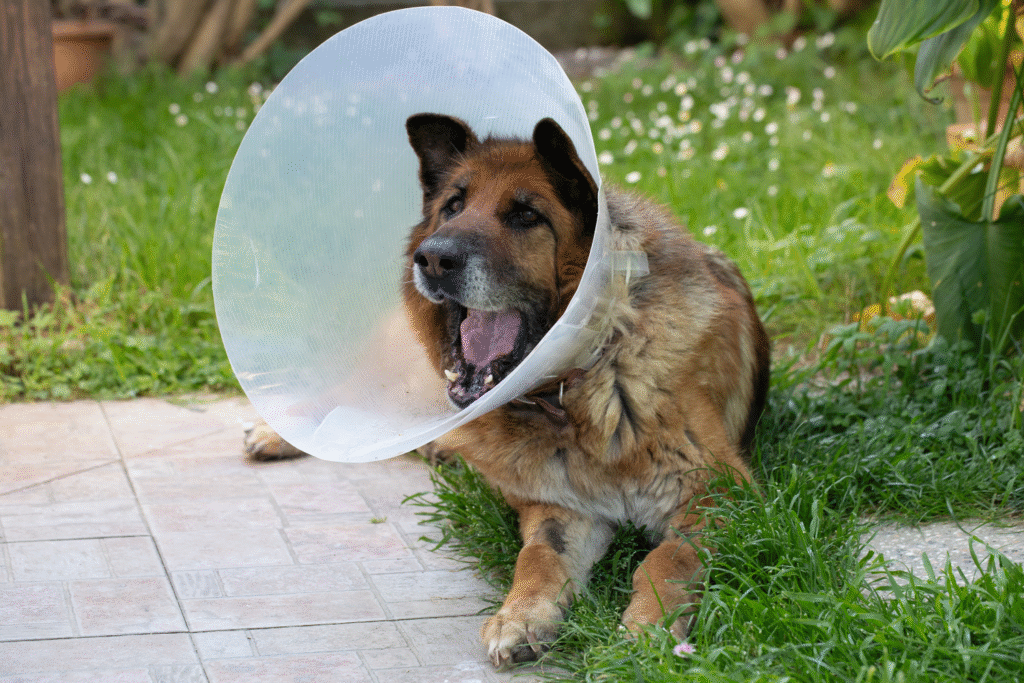When “aging” hides neurological warning signs.

Many dog owners attribute slow walking, forgetfulness, or trembling paws to simple aging. But in some cases, these signs mask neurological conditions that demand medical attention. Recognizing the distinction early can mean better treatment, improved quality of life, or even prevention of irreversible damage.
Dogs, unlike humans, hide pain and dysfunction until it’s advanced. That natural stealth makes it easier to dismiss issues as “just old age.” Below are nine neurological disorders commonly misread as aging—and clues to spot them early.
1. Cognitive dysfunction mimics dementia but is a disease.

Cognitive dysfunction syndrome (CDS), often compared to Alzheimer’s in humans, causes confusion, disorientation, and sleep-wake cycle reversal in senior dogs. It affects learning, memory, and awareness. As dogs age, accumulation of beta-amyloid plaques, neuronal loss, and brain atrophy contribute to CDS, according to research on canine brain aging.
When an older dog begins wandering in familiar rooms, pacing at night, or failing to respond, it’s easy to chalk these up to aging. But these changes may mark neuronal decline. Early diagnosis can allow interventions, diet, enrichment, medications, to slow progression and preserve function.
2. Intervertebral disc disease causes weakness and paralysis.

When spinal discs bulge or rupture, pressure on the spinal cord causes pain, limb weakness, dragging, or paralysis, symptoms often mistaken for arthritis or old joints according to veterinary neurology reports.
Because the onset may be gradual, many owners think stiffness or reluctance to climb stairs is simply “old age.” Yet IVDD is a mechanical injury to the nerves that may be medically or surgically treated. Getting prompt diagnosis can preserve mobility and avoid permanent nerve damage.
3. Degenerative myelopathy resembles hip arthritis.

Degenerative myelopathy (DM) causes progressive degeneration of the spinal cord in older dogs, especially in breeds like German Shepherds. The condition leads to hind limb weakness, knuckling, dragging of paws, and eventual paralysis. Researchers of geriatric neurological disease note that DM is one of the more common spinal disorders in aging dogs.
Because mobility loss is gradual, many think the dog is simply stiff. A key difference: DM affects deep neurologic control, not joint structures. Physical therapy and supportive care can slow decline even though a cure doesn’t yet exist.
4. Vestibular syndrome leads to sudden balance loss.

Vestibular disease appears suddenly. A dog may tilt its head, circle, stumble, or struggle to stand. Many dog guardians dismiss these as vertigo from age. But the vestibular system issue disrupts balance and spatial orientation—not just joint function.
Some cases resolve over weeks; others linger or recur. The distinction lies in onset speed and accompanying signs—nystagmus (rapid eye movement), disorientation, or vomiting accompany vestibular episodes, shifting the diagnosis from “senility” to inner ear or nerve involvement.
5. Brain tumors cause behavioral and cognitive shifts.

Intracranial masses may provoke seizures, personality changes, circling, or head pressing. Owners may interpret slower gait or reduced interest in walks as aging, not suspecting an expanding lesion pushing on the brain’s structures.
Imaging (MRI or CT) and neurologic evaluation can reveal masses early. Some tumors are treatable or palliative. Recognizing subtle shifts—like new compulsive behavior or head tilts—can raise red flags beyond simple ageing.
6. Chiari-like malformation creates chronic pain.

In toy breeds, a mismatch between skull and brain size can compress the brainstem region, triggering pain, scratching, or neurologic signs. Because symptoms often manifest slowly, owners might assume their pet is simply slowing down with age.
But CM (Chiari-like malformation) can cause neck pain, gait changes, or sensitivity. Imaging and neurosurgical assessment are needed. In some cases surgery or medical therapy helps ease symptoms and slow further neurologic damage.
7. Meningitis or encephalitis provoke acute decline.

Inflammatory diseases of the brain and spinal cord (meningitis, encephalitis) may cause fever, lethargy, seizures, head tilt, stiffness, or pain. Because onset can be sudden, some owners believe their old dog is having a collapse or stroke.
But unlike typical age decline, these diseases are acute and dangerous. Prompt diagnosis—via MRI, CSF analysis, labs—and aggressive therapy (immune suppression or antimicrobials) can be lifesaving. Delays often worsen outcomes.
8. Idiopathic head tremors mimic minor trembles.

Head tremor syndrome causes spontaneous lateral or vertical head movements that can seem like benign shakes seen in old dogs. Yet idiopathic head tremors are a neurologic condition, not simply aging. The cause is unknown; EEG, imaging, and neurologic workups help rule out other causes.
Tremors usually last 1–3 minutes and dogs stay alert. Because they do not always require treatment or cause long-term damage, they may go unnoticed or be accepted as part of aging. Awareness helps differentiate them from tremor due to disease.
9. Stroke (vascular event) causes sudden deficits.

Dogs may suffer ischemic or hemorrhagic strokes, suddenly losing function on one side, collapsing, or showing blindness or facial droop. Many owners dismiss sudden deficits in older animals as a “stroke from old age.” But unlike gradual change, strokes are abrupt.
Immediate veterinary neurological assessment is critical. Diagnostics including MRI or CT, bloodwork, and supportive management may recover function or stabilize the dog. Early therapy improves chances of meaningful recovery.
